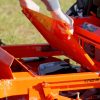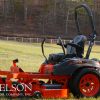You want a yard that’s the envy of the neighbors, but how do you turn Georgia soil into a lush expanse of perfectly mowed golf-course green? Don’t worry, it’s doable. It just takes a little know-how.
There are a lot of reasons your lawn might be a patchy disaster, especially when you buy a new property. The previous owners might have neglected it altogether or worse, used your future lawn as a parking lot. Whatever the reason, let’s say you’re starting with ground no self-respecting homeowner could be proud of and the neighbors are looking at you sideways. Time to hop on that riding mower and show them how it’s done.
Irrigation
The southeast is hot and dry most of the summer, and that’s hard on plants. Grass needs 1 inch of water per week. If there’s no rain, watering is up to you. For a large area, you’ll need to install an underground irrigation system if you don’t have one. You can dig your trench by hand, but renting a pipe puller that digs a narrow trench and lays the pipe at the same time is so much easier.
While you’re getting your irrigation system in place, send a few soil samples off to The University of GA Agricultural & Environmental Services Laboratory County Office for evaluation. Georgia soil tends to be low pH and and lacking some essential nutrients. A little extra care before laying your sod or seeding will help ensure a healthier lawn.
To conserve water and make sure the water sinks in and doesn’t just run off, water twice a week after dark – late evening or early morning.
Dethatching and aerating the soil
Thatch is a tightly woven mat of living plant material that compacts on top of the soil, preventing water and nutrients from penetrating. You can aerate, dethatch, and till with your subcompact tractor and a tilling implement or core aerator.
What kind of grass makes the best lawn?
There are several things to think about before you decide what kind of grass to plant:
How much sun will your lawn get? Bermuda or centipede grass grows best in full sun, while fescue varieties grow better in the shade.
What time of year are you planting? Turfgrasses come in endless variety and two general categories, cool season grasses and warm season grasses. If you’re planting in the fall (September through October), you’ll want a cool season grass. Walter Reeves, renown Georgia gardening expert, recommends tall fescue, Kentucky bluegrass, or ryegrass.
Warm season grasses, bermuda, zoysia, and centipede, should be planted from May through July. The most popular choice in south Georgia is Bermuda
Sod or seed? Seed is much cheaper, but can take several months to come in. For a lush lawn in no time, sod is the best choice.
Mowing and maintenance
Ok, you’ve dethatched, aerated, fertilized, sodded and set your watering schedule. The last step to a beautiful lawn is mowing. Here are a few tips to make the best of your mowing:
- For an even cut, keep your blades sharp and clean. Sharp blades make clean cuts. Dull blades tear, rip, and damage your grass. Clean your blades after each cut, and sharpen twice each season. Replace damaged blades as necessary, and make sure you install them correctly and balance the blades to prevent vibration.
- Cut to the right height for your grass.
- Zoysia grass is healthiest when short, ½ to 1½ inch
- Cut Kentucky bluegrass, fine fescue, centipede, Bermuda, and ryegrass 1½ to 2½ inches.
- St. Augustine, Bahia, and tall fescue thrive at 3 inches.
- To keep your lawn thick and green, many lawn pros in the know overseed their lawns. You can do that easily with your lawn tractor and a spreader attachment.
A good lawn takes love and devotion, and we know you’re up to the task. If you need attachments, maintenance or parts for your mower, lawn tractor or compact tractor to get it done right, give us a call.









